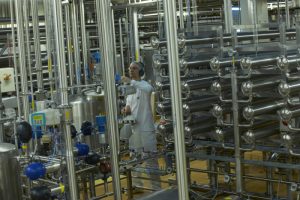Arla’s Nutrilac HiYield to enable diaries to use 100% milk
 Arla Foods Ingredients has developed a milk protein-based solution that enables dairies to utilise 100% of their milk in the manufacturing process – with zero by-products or waste.
Arla Foods Ingredients has developed a milk protein-based solution that enables dairies to utilise 100% of their milk in the manufacturing process – with zero by-products or waste.
Nutrilac® HiYield can be used to create a range of high quality dairy products that traditionally generate acid whey and permeate during production, including Greek yoghurt, cream cheese, Feta, Mascarpone, Ricotta, quark and skyr. Yields for these products are usually 25-50% of the milk used. In the case of Greek yoghurt, for example, in traditional processes only 33% of the milk ends up in the finished product: the remaining two thirds is acid whey. However, when using HiYield, 100% of the milk is used in the finished product, with no acid whey generated.
Arla Foods Ingredients is promoting HiYield as part of its Maximum Yield campaign – a new drive to raise awareness of how milk protein ingredients can enable dairy companies to maximise output, increase profits and significantly cut waste. It is highlighting that adding milk proteins to the production process can significantly increase a dairy’s efficiency and boost its sustainability credentials at the same time.
HiYield is a very flexible solution that requires little or no adjustment to existing production lines for common dairy products such as stirred yoghurt and cream cheese, because it eliminates the need for separation and filtration equipment. This means it is especially suitable for dairy companies seeking to enter new and emerging growth categories without investing in new machinery. When Arla Foods Ingredients supplies HiYield ingredients it also provides full technical expertise to ensure dairies are able to use them with the minimum of hassle.
Torben Jensen, Category & Application Manager for Fresh Dairy Products at Arla Foods Ingredients, said: “HiYield enables dairies to reduce their milk intake with no loss of milk solids, or to increase the output achieved from existing supplies. It’s a simple and lean solution that optimises a dairy’s production efficiency and helps to reduce its impact on the environment by maximising the use of milk and minimising waste.”


































